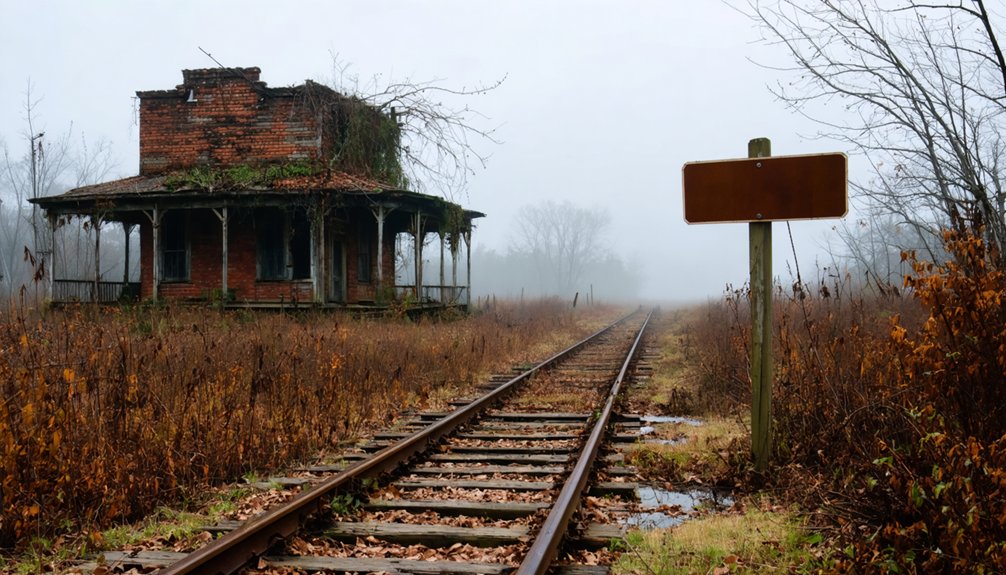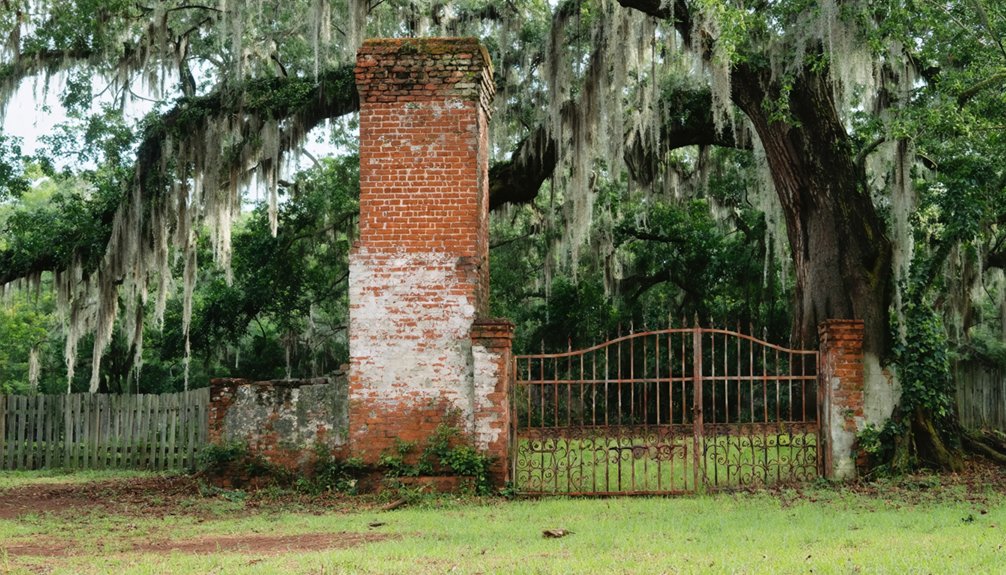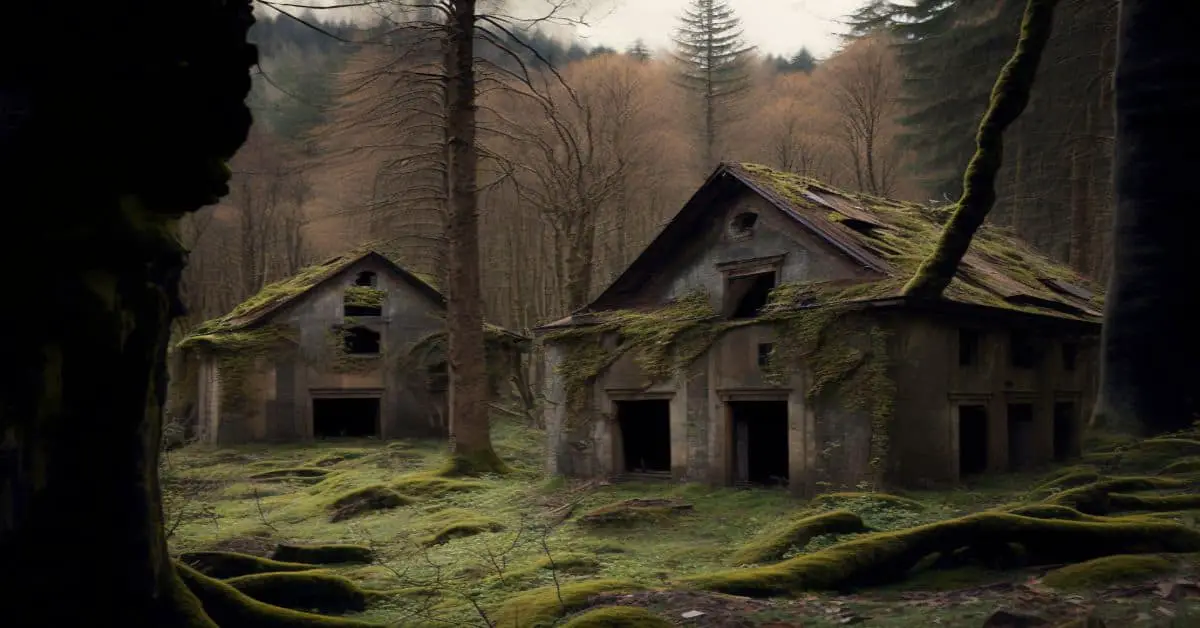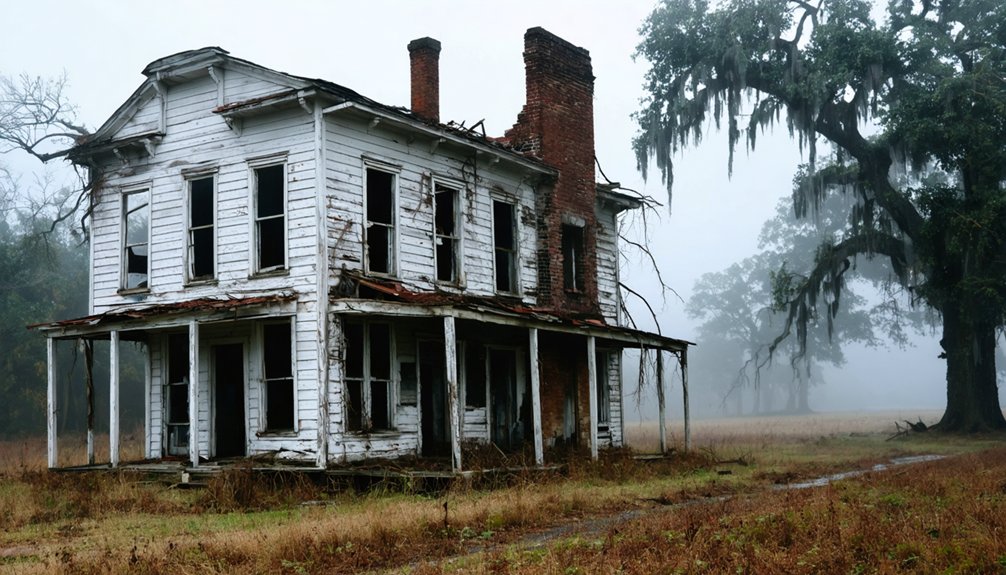You’ll find Troupville’s dramatic transformation from bustling county seat to ghost town at the junction of Georgia’s Withlacoochee and Little Rivers. Founded in 1837, it thrived with 500 residents, three hotels, and four stores by 1842. When the Atlantic & Gulf Railroad bypassed the town in 1860, residents physically moved their buildings four miles to the new railroad station at Valdosta. By 1874, what was once a vibrant community had become a “deserted village,” though its buried stories still whisper from the soil.
Key Takeaways
- Troupville was abandoned in 1860 when the Atlantic & Gulf Railroad bypassed the town, causing residents to relocate to nearby Valdosta.
- Originally established in 1837, Troupville flourished as a county seat with 500 residents before becoming a ghost town by 1874.
- The town’s buildings were physically moved to Valdosta when it became the new county seat, leaving only the cemetery behind.
- Economic decline was swift after losing its governmental importance and river-based commerce advantages to railroad-connected Valdosta.
- Archaeological remains and the Troupville Cemetery are the only physical evidence of this once-thriving 19th-century Georgia community.
The Rise and Founding of a County Seat
While settlers had struggled with previous county seat locations in Lowndes County, the establishment of Troupville in 1837 marked a strategic turning point in South Georgia’s development.
You’ll find its founding resulted from a careful selection process when commissioners identified an ideal location at the junction of the Withlacoochee and Little Rivers.
Named for Georgia’s states’ rights champion Governor George M. Troup, the town quickly attracted merchants and mechanics through strategic advertising campaigns.
The Georgia legislature made it official on December 14, 1837, designating Troupville as the county’s third seat.
After the failures of Franklinville and Lowndesville, Troupville’s position along stagecoach routes and potential river navigation promised the stability and accessibility the growing region desperately needed. By 1842, the thriving community reached 500 residents and included numerous mills and stores. The town’s success was evident as town lots sold for $3,443 in 1839.
Life Along the Withlacoochee River
Despite its frontier challenges, Troupville flourished as a vibrant river town throughout the 1840s, establishing itself as the commercial and social hub of Lowndes County. You’d find three hotels, four stores, and various shops buzzing with river commerce, while the local newspaper kept settlers informed of regional affairs.
Life along the Withlacoochee wasn’t always easy. Pioneer families like the Knights had to balance the opportunities of fertile soil against ever-present dangers. The dark, forbidding waters of the Withlacoochee River held many hidden perils for early settlers. Local militia under Major General Knight patrolled these waters in 1841 to protect settlers from Native American raids.
Evidence of indigenous habitation, marked by Indian mounds near the riverbanks, reminded settlers they weren’t the first to call this land home. You’d see stockades and forts dotting the landscape, offering protection from raids, while a popular racetrack north of town provided much-needed entertainment for the frontier community.
Transportation Challenges and Natural Barriers
The twin challenges of river crossings and unreliable transportation shaped daily life in Troupville throughout its existence. You’d face constant transportation hurdles living at the fork of the Little and Withlacoochee rivers, where natural obstacles made travel unpredictable and commerce difficult. Local settlers including Levi J. Knight conducted business despite these challenging conditions. The region’s timber industry struggled to transport goods efficiently during this period.
- You couldn’t count on the bridges staying intact, as freshets regularly destroyed these significant crossings, including the devastating Harrison Freshet of 1841.
- The town’s location between two rivers meant you’d deal with frequent flooding that disrupted daily activities.
- You’d find your travel routes severely limited when the waters rose, isolating the community.
- When the Atlantic & Gulf Railroad bypassed Troupville by four miles in 1859, you’d discover it was the final blow to the town’s viability.
Early Settlers and Community Life
You’ll find Troupville’s founding families were a mix of influential settlers, including the Knight family led by Rev. William A. Knight, who served as a religious leader for local Primitive Baptist churches, and the Smith family, who operated taverns and businesses.
Daily life centered around one-room or double log houses with mud-and-stick chimneys, while settlers focused on raising cattle, sheep, and clearing pine forests for crops. By 1849, the town had grown to include about 20 families.
The community’s social structure revolved around churches, hotels, and mercantile establishments, with regular gatherings at the horse racetrack located one mile north of town.
Prominent Founding Families
Several pioneering families shaped Troupville’s early development in the 1830s and 1840s, with the Knight family emerging as particularly influential through religious and civic leadership. When the railroad tracks arrived in 1860, the residents of Troupville relocated to what would become Valdosta five miles away.
You’ll find that Reverend William A. Knight led Primitive Baptist churches while Levi J. Knight helped establish the region’s foundations.
- Early settlers Benjamin Sirmans, Henry Hightower, and the Griffin brothers cleared land and built homesteads near the river confluences.
- Prosperous planters like Ivy Simmons and Matthew Young transformed the area into a thriving cotton market.
- Merchant families, including Mose Smith who opened the first store, established essential trade networks.
- Jewish immigrants such as the Ehrlichs contributed to the area’s economic diversity and growth, especially as railroad development expanded opportunities.
Daily Life Activities
During Troupville’s heyday, daily life revolved around a bustling mix of commerce, agriculture, and social gatherings that defined this frontier settlement.
You’d find yourself amid a lively atmosphere of trade and community events, especially during the infamous “court week” when locals gathered for horse racing and cock fighting.
The social hierarchy was evident in the mix of wealthy families and general townspeople, all participating in the town’s vibrant commercial scene.
At Morgan’s Spring, you could refresh yourself with pure water, while the Baptist and Methodist churches provided spiritual guidance.
Local blacksmith Morgan Goodgame Swain’s forge rang with activity, and mechanics’ shops buzzed with trade.
Like other small towns of the era, locals could settle lawsuits up to $1,500 in value at the courthouse.
The South Georgia Watchman newspaper kept you informed of local happenings, though the town’s reputation for “worldly amusements” often overshadowed its commercial importance.
William Smith’s excellent dining establishment attracted visitors seeking quality meals during their stay in town.
The Railroad’s Impact and Town’s Decline

The arrival of the Atlantic and Gulf Railroad in 1860 marked Troupville’s swift decline, as the tracks bypassed the once-thriving town by four miles in favor of the newly established Valdosta station.
The railroad decisions sealed Troupville’s fate, triggering economic consequences that would transform the region forever.
The impact was devastating and immediate:
- The county seat relocated to Valdosta, stripping Troupville of its governmental importance.
- Residents physically moved their homes and businesses to be near the rail line.
- River-based commerce collapsed as rail transport became the dominant shipping method.
- By 1874, you’d find nothing but a “deserted village” where Troupville once stood.
The toll bridge built in 1871 couldn’t save the town, and Troupville’s abandonment was complete as commerce and life gravitated toward railroad-connected Valdosta.
Archaeological Discoveries and Historical Legacy
Rich archaeological discoveries near Troupville reveal a complex history spanning from indigenous settlements to 19th-century pioneer life.
You’ll find evidence of sophisticated Native American civilization in the area’s burial mounds and stone architecture, showcasing remarkable indigenous craftsmanship through recovered tools and implements. The archaeological significance extends to nearby terrace complexes at Track Rock Gap and Sandy Creek Park.
The town’s 19th-century legacy lives on through the Troupville Cemetery, where you’ll discover the final resting places of pioneer families like the Ayers, Briggs, and Treadwells.
While the original settlement vanished after the railroad bypassed it in 1860, ongoing research by the Lamar Institute and Georgia’s Department of Transportation continues to uncover artifacts that tell the story of this historic crossroads.
Frequently Asked Questions
Are There Any Remaining Structures or Ruins Visible at the Troupville Site Today?
Like Ozymandias’s fallen kingdom, you won’t find any remaining structures or visible ruins at the site today – the once-bustling county seat has completely vanished beneath time’s relentless march.
What Was the Peak Population of Troupville Before Its Decline?
You’ll find historical significance in the peak population estimate of several hundred residents before decline, though exact numbers weren’t recorded during Troupville’s 1830s-1850s heyday as county seat.
Did Any Notable Civil War Events or Skirmishes Occur in Troupville?
Like a drive-by shooting, a Civil War skirmish hit Troupville (then Salt Springs) on October 1, 1864. You’ll find records showing Confederate and Union cavalry units clashed there during wider regional operations.
Were There Any Schools or Churches Established During Troupville’s Active Years?
You’ll find records confirm three churches operated there, showing religious influence, but the education history remains unclear with no documented schools during Troupville’s peak years before 1860.
What Native American Tribes Originally Inhabited the Area Before Troupville’s Establishment?
You’d find the Yuchi as original inhabitants, while Creek culture dominated the region by the 1700s. The Hitchiti, who were closely related to the Creek, also lived throughout this territory.
References
- https://raycityhistory.wordpress.com/2010/10/18/more-about-troupville-ga-and-the-withlacoochee-river/
- https://driftwoodchronicle.wordpress.com/2016/10/11/gone-with-the-wind-ghost-towns-of-georgia/
- https://www.georgiahistory.com/ghmi_marker_updated/troupville/
- https://wwals.net/2024/10/24/new-troupville-town-historic-marker-on-ga-133-just-west-of-the-withlacoochee-river-2024-10-23/
- https://raycityhistory.wordpress.com/2020/10/26/augustin-and-the-ghost/
- https://en.wikipedia.org/wiki/List_of_ghost_towns_in_Georgia_(U.S._state)
- https://www.enwoven.com/collections/view/15368
- https://www.hrcga.org/grooverville-georgia-ghost-town-history/
- https://en.wikipedia.org/wiki/Troupville
- http://sites.rootsweb.com/~gagus/lowndesh.htm



